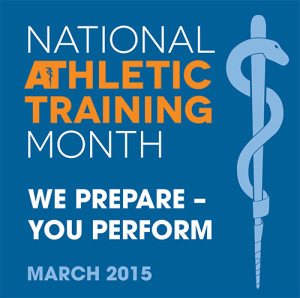I am a naprapath as well as an athletic trainer. I have been a certified athletic trainer for 15 years and worked as an athletic trainer at NCAA Division I athletics for 12 years. As a naprapath, I still have utilized knowledge, skills and experiences that I have earned from athletic training. Athletic training has been an important part of my career. Since March is National Athletic Training Month, I would like to promote athletic training. These are 5 things that you should know about athletic trainers.
1. Athletic Trainers are well-known, recognized, qualified health care professionals.
Athletic trainers are highly qualified and multi-skilled health care professionals who provide:
- Preventative services
- Emergency care
- Clinical diagnosis
- Therapeutic intervention
- Rehabilitation of injuries and medical conditions
Athletic trainers are listed under the allied health professions category as defined by Health Resources Services Administration (HRSA) and Department of Health and Human Services (HHS). They also have belonged to the American Medical Association’s Health Professions Career and Education Directory for more than 10 years. Athletic trainers are given National Provider Identifier (NPI) numbers as all other health care professionals.
2. Athletic trainers provide services to people of all age groups.
You might think that athletic trainers work only at athletic settings such as college athletics and professional sports teams; however, that is not true. As a matter of a fact, more than 50% of athletic trainers work outside of school athletic settings. Athletic trainers work in such as
- Physician offices as physician extenders.
- Hospital emergency rooms, urgent and ambulatory care centers.
- Clinics with specialized in sports medicine, cardiac rehab, medical fitness and physical therapy.
- Commercial settings such as manufacturing, distribution and offices for assisting with ergonomics.
- Military settings, Police and fire departments.
- Secondary schools, colleges and universities, professional and Olympic sports.
- Youth leagues and youth sports facilities.
3. Approximately 70% of athletic trainers have a master’s or doctoral degree.
Athletic trainers are highly educated professionals. Approximately 70% of athletic trainers have a master’s or doctoral degree. Common their master’s degrees are in:
- Athletic training
- Health promotion
- Exercise physiology
- Motor control
- Nutrition
- Education
- Administration
4. Athletic trainers help to save lives at immediate and emergency care situations.
Athletic trainers are educated and trained to provide standard immediate and emergency care to clients who suffer from cardiac events, brain injuries and environmental issues. Cardiac events includes sudden cardiac arrest. Athletic trainers are certified for CPR and AED. Brain injuries include traumatic brain injuries (TBIs) also known as concussion and cervical spine injuries. Environmental issues include illness from heat and cold and chronic health issues such as sickle cell trait and diabetes. Athletic trainers are able to assess and appropriately manage these conditions.
5. Call us “Athletic Trainers” not “Trainers”.
We are athletic trainer not “trainers”. Many people seem to be confused between athletic trainer and fitness/personal trainers. These are differences between these occupations.
Athletic Trainers
Recognize, treat and prevent musculoskeletal injuries.
Meet qualifications set by BOC.
Are Members of health care profession recognized by American Medical Association.
Must have at minimum a bachelor’s degree in AT.
Must pass a BOC exam.
Must earn CEU.
Provide physical medicine and rehab services.
Prevent, diagnose, treat and rehab both acute and chronic injuries.
Coordinate care with physicians and other health care professionals.
Work in school, professional sports, clinics, hospitals, industry and military.
Personal Trainers
Develop and monitor an individual’s exercise program in a fitness setting.
Can earn credentials through a number of agencies.
Can work without formal instruction or certification.
May or may not have higher education in health sciences.
May or may not be required to have certification.
May or may not earn CEU.
May become certified by any organizations.
Assess fitness needs and design exercise programs.
Work with clients to achieve fitness goals.
Educate clients on importance of physical activity.
Work in health club, wellness centers.
Reference: www.nata.org


